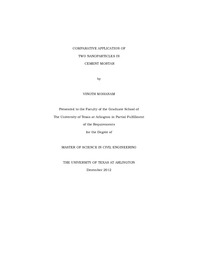
ATTENTION: The works hosted here are being migrated to a new repository that will consolidate resources, improve discoverability, and better show UTA's research impact on the global community. We will update authors as the migration progresses. Please see MavMatrix for more information.
Show simple item record
| dc.contributor.author | Mohanam, Vinoth | en_US |
| dc.date.accessioned | 2013-07-22T20:15:42Z | |
| dc.date.available | 2013-07-22T20:15:42Z | |
| dc.date.issued | 2013-07-22 | |
| dc.date.submitted | January 2012 | en_US |
| dc.identifier.other | DISS-11997 | en_US |
| dc.identifier.uri | http://hdl.handle.net/10106/11902 | |
| dc.description.abstract | Carbon Nanotubes (CNTs) and Carbon Nanofibers (CNFs) are two of the most promising advanced materials in the construction industry due to their excellent material properties. In this study, their application in cement mortar is studied comparatively as possible choice for concrete repair. CNT and CNF have very high aspect ratio due to which the Van der Wal forces between the CNT and CNF tend to agglomerate; thus forming bundles. In order to achieve proper dispersion, ultrasonic energy was used to disperse the CNT and CNF in the aqueous solution. The mechanical properties such as compressive strength and flexural strength of CNT and CNF cement composites were studied and compared with cement mortar. Flow test was conducted to investigate the workability of the cement composites. In this study, 0.1% and 0.2% of both CNT and CNF by weight of cement and ratio of 0.008 (super plasticizer to cement) was used. Water cement ratio of 0.35, 0.40, 0.45 and 0.50 were used along with a super plasticizer. Samples with water cement ratio of 0.45 and 0.1% performed better compared to all other composites. There is a significant increase in compressive strength for both CNT and CNF samples by 54.5% and 67.5%, and a significant increase in flexural strength by 14.06% and 8.84% at 28 days, respectively. SEM (Scanning Electron Microscope) images were taken to verify the rate of dispersion in CNT and CNF composites. Bleeding, setting time and slant shear test results of the CNF and CNT composites were examined to assess the quality of cement composites as a repair material. Similar to ordinary cement paste, no bleeding was found for both the CNT and CNF cement composites. The CNF and CNT composites exhibited faster setting time compared to the ordinary cement paste containing super plasticizer. Slant shear test results indicated that the bond strength of epoxy resin was relatively close to the CNT composites at 28 days considering the effect of thermal aging for epoxy. Bond strength of CNF samples was low compared to both CNT composites as well as epoxy resin. Thus, the excellent compressive strength and flexural strength makes the CNT and CNF material to as a strong candidate for the repair of cracks and spalling of concrete. | en_US |
| dc.description.sponsorship | Yazdani, Nur | en_US |
| dc.language.iso | en | en_US |
| dc.publisher | Civil & Environmental Engineering | en_US |
| dc.title | Comparative Application Of Two Nanoparticles In Cement Mortar | en_US |
| dc.type | M.S. | en_US |
| dc.contributor.committeeChair | Yazdani, Nur | en_US |
| dc.degree.department | Civil & Environmental Engineering | en_US |
| dc.degree.discipline | Civil & Environmental Engineering | en_US |
| dc.degree.grantor | University of Texas at Arlington | en_US |
| dc.degree.level | masters | en_US |
| dc.degree.name | M.S. | en_US |
Files in this item
- Name:
- Mohanam_uta_2502M_11997.pdf
- Size:
- 2.505Mb
- Format:
- PDF
This item appears in the following Collection(s)
Show simple item record


